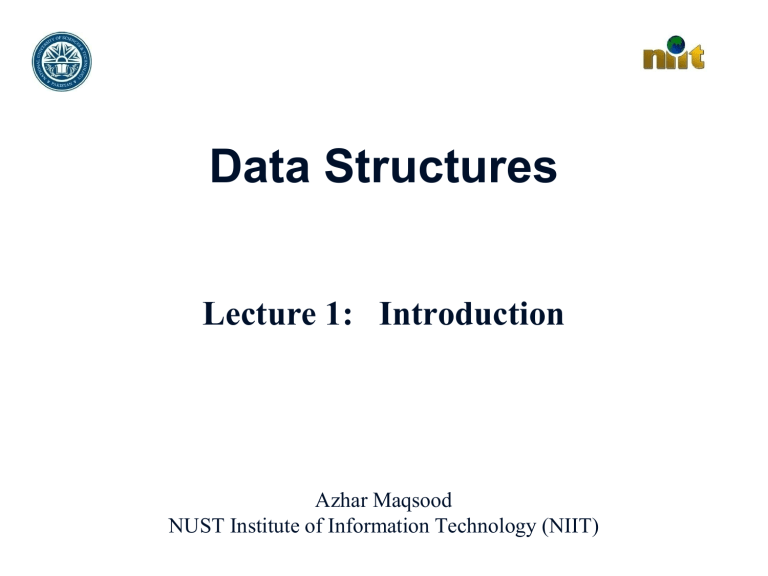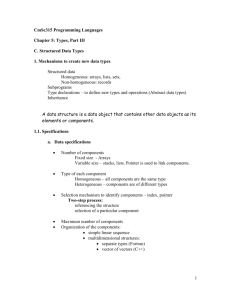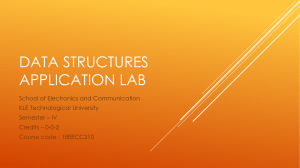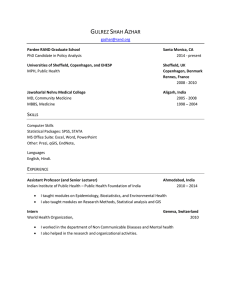Lecture 01 Intro

Data Structures
Lecture 1: Introduction
Azhar Maqsood
NUST Institute of Information Technology (NIIT)
Administrative
Instructor: Azhar Maqsood
azhar.maqsood@niit.edu.pk
Extension: 136
Academic Block 2, Faculty Office
Web Address : http://www.niit.edu.pk/~azhar
Consulting hours:
Tuesdays and Thursdays
Depends on your schedule
Email me and get in touch if in need
Regularly check course folder in FileSvr and My website
Course Contents
Data Types
Overview, Introductory concepts
Data Types, meaning and implementation
Abstract data types (ADT)
Arrays (revisited)
Structures
Linked Lists
Stacks (recursion)
Queues
Trees (traversals, implementation)
Course Contents
Binary Trees
Indexing Methods
Hashing
Binary Search Trees
Balanced Search Trees
(AVL Tree) Adelson-Velskii-Landis
Heaps
Splay Trees
Graphs, adjacency matrices and lists
Text book
“Data structures using C and C++”, Yedidyah
Langsam, Moshe J Augenstein and Aaron M.
Tenenbaum, 2 ed, 2002
Reference Books:
• D. Wood: “Data structures, algorithms and performance”,
Addison-Wesley, 1993
• C++ Data Structures by Nell Dale and David Teague
• http://www.brpreiss.com/books/opus4/html/book.html
•
Any other book on Data Structures
Assignment Policy
DO NOT copy assignments
Both of the copy cases will be graded zero
Submission time will be 1500 hrs on the due date
NO credit on LATE submission of any deliverable.
No excuse of USB/Floppy/email servers not working
Sorry! No Exceptions
OHT’s
Quizzes
Assignments
Project
Final Test
Weightage
30% (15 +15)
10%
10%
5%
45%
Minimum Quizzes : 5-6 (Unannounced)
Assignments : 1 Every 3 weeks
Honor Code
Dishonesty will NOT be tolerated.
Will result in zero marks in the corresponding work
Lets start the course!
Why Study?
Designed to develop students understanding the impact of structuring data to achieve efficiency of a solution to a problem
After completion you will be familiar with important and most often used data structuring techniques.
It will enable you to understand the manner in which data is organized and presented later.
Objectives of the course
Present in a systematic fashion the most commonly used data structures, emphasizing their abstract properties.
Discuss typical algorithms that operate each kind of data structure, and analyze their performance.
Compare different Data Structures for solving the same problem, and choose the best
Abstract Data Type ADT
A data type whose properties (domain and operations) are specified independently of any particular implementation
ADT is a mathematical model which gives the a set of utilities available to the user but never states the details of its implementation.
In OO-Programming a Class is an ADT
Data Structures: Definition
A collection of data elements whose organization is characterized by accessing operations that are used to store and retrieve the individual data elements;
The logical arrangement of data as used by a system for data management; a representation of a data model in computer form
Data Structures: More specifically
A data structure is a way of grouping fundamental types (like integers, floating point numbers, and arrays) into a bundle that represents some identifiable thing.
For example, a matrix may be thought of as the bundle of the number of rows and columns, and the array of values of the elements of the matrix. This information must be known in order to manipulate the matrix.
C introduced the struct for declaring and manipulating data structures. C++ extended the struct to a class
Goals of Data structures
Identify and develop useful mathematical entities and operations and to determine what classes of problems can be solved by using these entities and operations.
Determine representation of those abstract entities and to implement the abstract operation on these concrete representations.
A Real Life Example
Electronic Phone Book
Contains different DATA :
- names
- phone number
- addresses
Need to perform certain OPERATIONS :
- add
- delete
- look for a phone number
- look for an address
How to organize the data so to optimize the efficiency of the operations
Lisa
Michele
John
110
622-9823
112-4433
75
Bronson
Paola
The first Data Structure
An Array!
Word about Arrays!
Lets Get Started:
Arrays are data structures
Finite
Contiguous
Fast
Direct Access
All elements of same data type
(Can be based upon primitive or ADT)
Insertion / Deletion ??? HOW??
Arrays
How to Input arrays
How to process arrays
How to insert an item in an array
How to delete an item from an array
How to pass an array
Array
2 3 7 8
How to add 4
2 3 4 7 8
How to add 1 in the array?
Not possible









